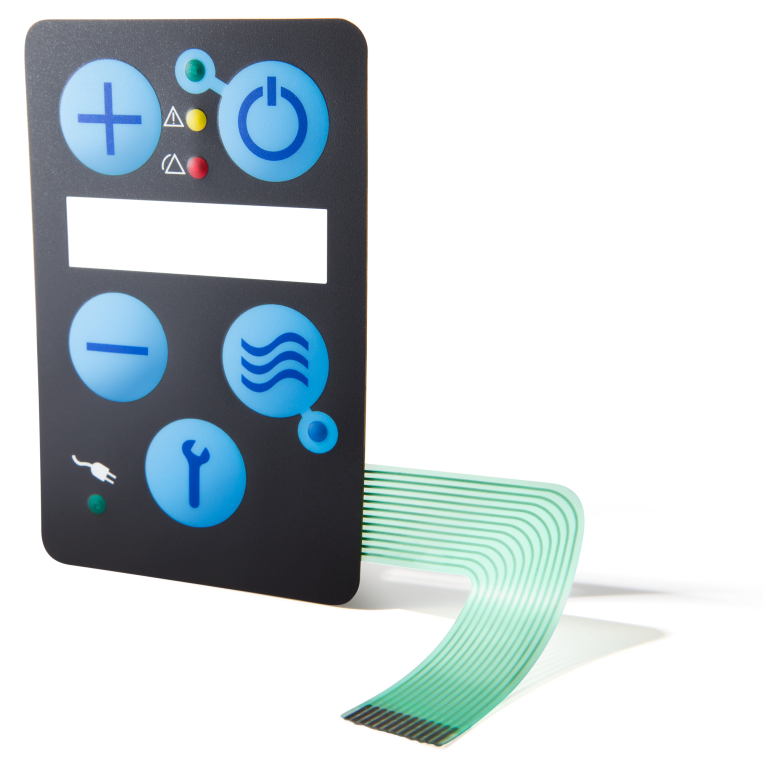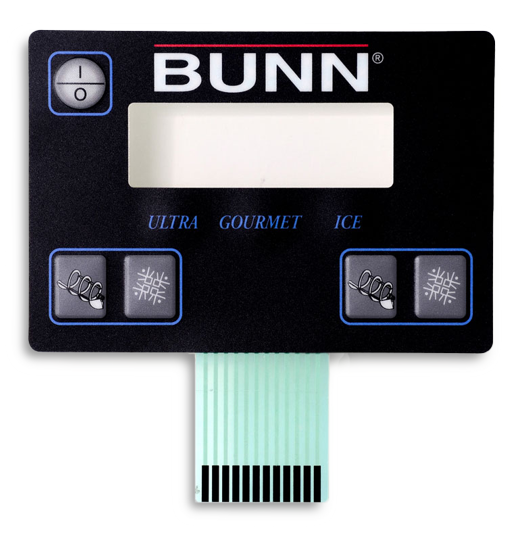Cutting-Edge Technology from a Trusted Membrane Switch Manufacturer
Cutting-Edge Technology from a Trusted Membrane Switch Manufacturer
Blog Article
Checking Out the Manufacturing Refine of Membrane Switch for Different Industries
The manufacturing process of Membrane buttons is a complicated undertaking that requires precision and focus to detail. From picking suitable products to carrying out strenuous high quality control steps, each step plays a vital duty in making certain capability. Various sectors, including clinical and automobile, depend on these elements for their distinct applications. Recognizing the details of this process reveals substantial understandings right into just how these switches are created and their influence across diverse industries.
Comprehending Membrane Changes: A Review

Key Materials Utilized in Membrane Switch Production
In Membrane button production, the selection of essential materials substantially influences capability and sturdiness. Conductive materials, adhesives, and finishings play important functions, while substratum choice influences total performance and reliability. Recognizing these components is necessary for enhancing the style and manufacturing of Membrane switches.
Conductive Materials Overview
Conductive materials play an essential function in the capability of Membrane switches, making sure trustworthy electrical links within the tool. Generally utilized products include silver, copper, and carbon-based inks, each offering distinctive advantages. Silver is favored for its high conductivity and sturdiness, making it ideal for applications requiring durable efficiency. Copper, while slightly less conductive than silver, is an economical alternative frequently made use of in printed circuits. Carbon-based inks provide a versatile option, appropriate for applications where versatility and lower costs are prioritized, although they have actually lower conductivity contrasted to steel options. The selection of conductive materials directly influences the general reliability, life expectancy, and performance of the Membrane switch, making it a crucial factor to consider in the production process.
Adhesives and Coatings
Coverings and adhesives are vital parts in the manufacturing of Membrane buttons, giving important bonding and safety buildings. These products guarantee that different layers of the switch, consisting of graphic overlays and wiring, stick firmly to each other, improving longevity and performance. Typically used adhesives include pressure-sensitive adhesives (PSAs) and epoxy-based formulas, which offer solid adhesion and strength. Coatings, such as polyurethane or acrylic, offer to protect versus environmental factors, consisting of moisture, abrasion, and chemicals. Furthermore, finishes can improve responsive comments and aesthetic appeal, adding to the overall customer experience. The selection of proper adhesives and coatings is essential for optimizing efficiency and durability in diverse applications across numerous industries, guaranteeing that Membrane changes meet details operational needs.
Substratum Choice Elements
Substrate choice plays a necessary role in the production of Membrane switches, as it significantly influences their general performance and toughness. Key products such as polyester, polycarbonate, and adaptable printed circuit boards (FPCBs) are commonly used for their distinctive homes. Polyester is favored for its cost-effectiveness and resistance to abrasion, making it suitable for applications with high wear. Polycarbonate deals remarkable clarity and impact resistance, ideal for settings requiring high exposure. FPCBs give improved flexibility and are often utilized in complicated styles. The choice of substratum additionally impacts elements like thermal security, chemical resistance, and simplicity of printing. Ultimately, choosing the ideal substrate is vital for ensuring the performance and long life of Membrane switches over throughout various markets.
The Design Refine of Membrane Switches Over
The design procedure of Membrane buttons is a vital phase that substantially influences the functionality and visual appeals of the last item - membrane switch manufacturer. It begins with specifying the particular needs of the application, including measurements, button layout, and tactile comments preferences. Developers have to think about user communication, making certain that the button is intuitive and accessible.Next, materials are selected based upon resilience, versatility, and environmental resistance. The integration of graphics and branding aspects is additionally crucial, as it boosts aesthetic charm and communication. Prototyping enables for iterative testing, making it possible for changes based upon customer feedback and performance evaluations.Additionally, the layout has to account for the electric components, such as adapters and circuits, making sure integrity and simplicity of use. Inevitably, a successful style integrates functionality, aesthetics, and customer experience, leading the way for efficient production and long-lasting efficiency in different industries
Printing Techniques for Membrane Changes
The printing methods made use of in Membrane switch production play an important role in identifying the end product's high quality and capability. Screen printing offers benefits such as resilience and dynamic shade application, while digital printing technologies offer flexibility and accuracy in style. Comprehending these approaches can substantially affect the overall efficiency of Membrane buttons in different applications.
Display Printing Advantages
Many benefits make screen printing a preferred strategy for producing Membrane buttons. This approach enables for top quality, comprehensive designs and vibrant shades, which are important for interface applications. Display printing is specifically reliable for using thick ink layers, improving resilience and tactile comments. Additionally, it offers outstanding bond to different substrates, making certain long life popular atmospheres. The process is cost-effective for large production runs, as it minimizes arrangement time and waste. Additionally, display printing sustains a large range of inks, including specialty and UV-curable alternatives, allowing convenience in layout. Its capacity to produce constant outcomes across multiple systems makes it a dependable choice for producers going for high quality and performance in Membrane switch manufacturing.
Digital Printing Innovations

Advancements in electronic printing modern technology are transforming the production of Membrane switches, using manufacturers ingenious options that improve layout flexibility and effectiveness. Digital printing enables for intricate designs and high-resolution graphics, enabling customized branding and capability without the constraints of traditional techniques. This strategy reduces setup times and costs, assisting in shorter production runs and minimal waste, making it perfect for services with differing needs. In addition, innovations in ink formulations supply much better toughness and attachment, making sure long life in different atmospheres. As industries progressively seek individualized and complicated layouts, digital printing stands apart as a vital strategy, setting a brand-new standard in Membrane switch production. The combination of these innovations placements suppliers to fulfill advancing market requires efficiently.
Assembly and Layering of Membrane Switch Parts
Careful setting up and layering of Membrane button parts are important to ensuring performance and toughness. This process starts with the accurate positioning of different layers, consisting of the graphic go to my site overlay, glue, circuit layer, and backing product. Each component has to be very carefully positioned to keep electrical stability and interface responsiveness.During assembly, conductive traces are used to the circuit layer, usually made from materials like polyester or polycarbonate. This layer is important, as it beams when pressure is applied. The glue utilized for bonding these layers is additionally chosen for its capacity to sustain environmental stress and anxieties while preserving a safe and secure bond.Heat and pressure are frequently used throughout the assembly process to ascertain that the layers stick appropriately without jeopardizing the functionality of the button. Ultimately, interest is provided to the edge sealing to shield against wetness and contaminants, securing the durability of the Membrane button in various industrial applications.
Quality Control Steps in Membrane Switch Production
Quality control actions play a necessary duty in making certain the integrity and performance of Membrane switches adhering to the setting up and layering of their components. In the production process, several key examinations are performed to promote top quality requirements. These consist of visual evaluations for problems in printing and adhesive application, as well as useful examinations to validate the responsiveness of each switch.Additionally, ecological screening is done to evaluate the switches' toughness against temperature variations and moisture direct exposure. Makers typically execute statistical process control (copyright) methods to check production uniformity, allowing early discovery of anomalies.Furthermore, traceability systems are established to track materials and components, ensuring liability and assisting in recalls if necessary. Calibration of tools and adherence to market standards are additionally important to keeping product integrity. Jointly, these quality assurance procedures safeguard the efficiency of Membrane changes throughout different applications, ultimately improving consumer fulfillment.
Applications of Membrane Changes Throughout Different Industries
Membrane switches are used throughout a diverse range of industries, showcasing their convenience and versatility. In the clinical field, they offer trusted and water resistant interfaces for tools such as diagnostic my response equipment and infusion pumps, making sure health and ease of use. The auto market employs Membrane buttons for dashboard controls, allowing seamless interaction between the motorist and lorry systems.In customer electronic devices, these buttons are located in devices and portable tools, using a sleek, modern visual while boosting performance. Industrial applications additionally leverage Membrane switches over for machinery control board, where resilience and resistance to extreme conditions are essential.Furthermore, the aerospace and protection markets make use of Membrane buttons for cockpit instrumentation and communication systems, prioritizing reliability and efficiency under extreme conditions. Overall, Membrane buttons play a crucial role in boosting the individual experience and operational performance across numerous domain names.
Often Asked Concerns
For how long Does It Require To Produce a Membrane Switch?
The manufacturing time for a membrane layer switch typically varies from a few days to several weeks - membrane switch manufacturer. Variables influencing this period include layout complexity, material availability, and production quantity, all influencing the total timeline markedly
What Is the Common Lifespan of a Membrane Switch?
The typical life expectancy of a membrane button generally varies from 1 to 5 million actuations, depending on aspects such as material top quality, environmental problems, and use regularity, check over here significantly influencing sturdiness and general performance.
Can Membrane Changes Be Custom-made for Certain Applications?
Membrane buttons can undoubtedly be customized for details applications. Their style adaptability permits modifications in size, form, shades, and graphics, making sure compatibility with unique needs across different sectors and enhancing capability and customer experience.

Are Membrane Switches Over Eco-friendly?
The ecological impact of Membrane switches over differs. Some materials utilized may not be environmentally friendly, while innovations in producing procedures are progressively concentrating on sustainability, intending to lower waste and advertise recyclable parts in their manufacturing.
What Are the Common Failure Modes of Membrane Switches?
Usual failing settings of Membrane switches include delamination, sticky failure, damage from use, wetness access, and electric failings. These concerns can substantially affect functionality, performance, and life expectancy in different applications throughout various sectors. Membrane buttons can be tailored to fit specific style demands, such as performance, shape, and dimension, making them very adaptable.The building and construction generally involves multiple layers, including a graphic overlay, adhesive, and a circuit layer, which work together to produce a smooth customer experience. In Membrane button production, the option of key materials considerably affects performance and toughness. The auto sector employs Membrane buttons for control panel controls, making it possible for smooth communication in between the driver and vehicle systems.In customer electronic devices, these switches are located in devices and portable gadgets, using a streamlined, contemporary aesthetic while enhancing functionality. Industrial applications additionally leverage Membrane switches for machinery control panels, where toughness and resistance to rough problems are essential.Furthermore, the aerospace and defense fields utilize Membrane buttons for cockpit instrumentation and interaction systems, focusing on dependability and performance under extreme problems. Membrane switches can without a doubt be tailored for particular applications.
Report this page